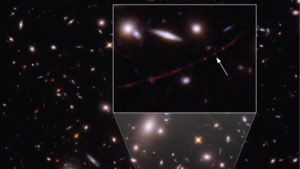Earendel

On March 30, 2022, Astronomers using the Hubble Space Telescope published a paper in Nature, announcing they had found a star they dubbed Earendel that was 12.9 billion light-years from Planet Earth.[1][2] At 12.9 billion light years it would be not only the most distant star yet detected, but also the oldest.
Detection of the star was possible because it was at the focus of a Gravitational lens.[1] Forbes magazine reported that the star was detected during the work of the Reionization Lensing Cluster Survey (RELICS) Program.[2] RELICS job was to find distant galaxies worthy of further study by the new James Webb Space Telescope.
The official designation is WHL0137-LS, and it is at least 50 times the mass of Sol, our sun, and on the order of a million times as bright. The unofficial name, Earendel, is a word from the Old English language, meaning "first light", as this star shone within the first billion years of our Universe.
The galaxy Earendel was found in is known as "The Sunrise Arc", as the gravitational lensing from a supercluster between us and them has smeared the galaxy into a long arc.[3]
Brian Welch, the lead author of the study that announced the star, said "This finding gives us an opportunity to study a star in detail in the early universe".[1]
Welch assembled a large team to analyze Earendel, and confirm that it was a star, or a pair of binary stars.[3] That team studied the images for three and a half years, prior to publication. According to The Verge, magnification from gravitational lenses are lumpy, due to the lumpiness of the galaxies that form the lenses. This means some regions get much higher levels of magnification than nearby regions. Objects that are near the lens' critical curve, are particularly highly magnified. Earendel's closeness to the lens's critical curve meant the lens was magnifying it 1,000 to 40,000 times.
The star considered the most distant, prior to finding Earendel, was detected in 2018, and, at 9 billion lightyears, was over four times older.[2]
rough work
References
- ↑ 1.0 1.1 1.2 1.3 Charles Q. Choi. Hubble Space Telescope spots most distant single star ever seen: Meet Earendel, a star 12.9 billion light-years from Earth, Space.com, 2022-03-30. Retrieved on 2022-03-30.
- ↑ 2.0 2.1 2.2 Jamie Carter. Meet ‘Earendel,’ Hubble’s Record-Breaking New Farthest Individual Star Ever Seen At 12.9 Billion Light-Years, Forbes magazine, 2022-03-30. Retrieved on 2022-03-30. “The amazing discovery—described by NASA as “record-breaking”—was published today in Nature today.”
- ↑ 3.0 3.1 Rafi Letzter. Meet Earendel, the most distant star ever detected: The star, imaged by the Hubble telescope, shone just 900 million years after the Big Bang, The Verge, 2022-03-30. Retrieved on 2022-03-30. “Earendel’s home galaxy, the Sunrise arc, takes its name from that gravitational lensing effect that made this discovery possible.”
- ↑ Welch, Brian (30 March 2022). "A highly magnified star at redshift 6.2". Nature 603. DOI:10.1038/s41586-022-04449-y. Retrieved on 30 March 2022. Research Blogging.
- ↑ Andrea Gianopoulos. Record Broken: Hubble Spots Farthest Star Ever Seen, NASA, 30 March 2022. Retrieved on 30 March 2022.
- ↑ Michelle Starr. The Most Distant Single Star Was Just Detected, as Ancient as The Cosmic Dawn, ScienceAlert, 30 March 2022. Retrieved on 30 March 2022.
- ↑ John Timmer. Hubble picks up the most distant star yet observed - Gravitational lensing has amplified the light of what may be a single star., Ars Technica, 30 March 2022. Retrieved on 30 March 2022.
- ↑ Distant star found by Hubble telescope may be earliest we will ever see, The Guardian, 2022-03-30. Retrieved on 2022-03-30.